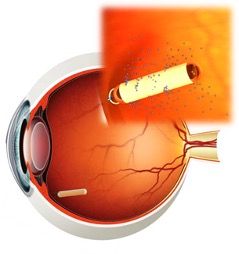Encapsulated cell technology delivery of ciliary neurotrophic factor: promising treatment for macular telangiectasia type 2
With orphan drug and fast track status, Neurotech plans to seek FDA approval for its NT-501 Implant platform late next year.

Idiopathic macular telangiectasia type 2 (MacTel type 2) is a rare, bilateral, slowly progressive, macular degenerative disease, typically diagnosed in middle age. It is primarily a neurodegenerative disease, but also affects Müller glia, retinal pigment epithelial cells, and blood vessels.1
Although it rarely results in total blindness, MacTel type 2 is associated with blurred and distorted vision, and therefore has a serious impact on patients’ quality of life. Central vision loss, caused by retinal atrophy can occur in late stages while neovascular complications may occur at any stage. There is currently no known effective therapy.
Background
Neurotech Pharmaceuticals, Inc. has created genetically engineered cell lines that can be customized to produce various therapeutic proteins through its proprietary encapsulated cell technology (ECT) platform. Neurotech’s NTC-200 cell line is derived from normal human retinal pigment epithelial cells and thrives under low oxygen and low nutrient conditions making it particularly amenable to genetic manipulation under stringent selection methods.
Related: Common types of retinal disorders explored (video)
The cell line can be genetically engineered to produce clinically relevant levels of therapeutic protein through a versatile, implantable drug delivery platform designed for long-term drug delivery. This novel cell-based delivery system has received Orphan Drug and Fast Track status from the FDA for MacTel type 2.
Neurotech has a unique partnership with the Lowy Family Group (LFG) and Lowy Medical Research Institute (LMRI). LMRI is a private, non-profit biomedical research organization dedicated to the study of MacTel type 2. Established in 2005, by LFG, LMRI’s mission is dedicated to preventing vision loss in people with MacTel type 2.
Related: Laser imaging system may offer early detection, treatment for eye diseases that cause blindness
LMRI maintains the world’s largest MacTel type 2 patient registry, performs MacTel type 2-related natural history studies, and pursues important basic science, preclinical, and clinical research opportunities. Their goal is identify the cause(s) of MacTel and to ultimately contribute to the development of new therapies for patients with MacTel type 2.
It has been estimated that MacTel type 2 afflicts up to 1 in 1,0002,3 individuals, although the incidence is likely to be higher due to difficulty in diagnosis. Most patients are diagnosed in their 40’s and 50’s; both eyes are typically affected, resulting in deterioration of central vision over a period of 10 to 20 years.4
Clinical Results
Schematic of NT-501 Implant residing in the vitreous. Stable, endogenous secretion of the therapeutic protein assures that the availability of the protein at the target site is not only continuous but also long-term.

The NT-501 Implant consists of genetically modified human retinal pigment epithelium cells, encapsulated in a semipermeable hollow fiber membrane, that release ciliary neurotrophic factor (CNTF) into the vitreous cavity. Previous data from several hundred patients showed that the treatment was well tolerated with a good safety profile and sustained activity over many years.
Results of a Phase 2 study (NCT01949324) that enrolled 67 patients (99 eyes) at 11 sites and randomized eyes to receive the NT-501 Implant containing CNTF or a sham procedure have been published.5 The primary endpoint was a change in a loss of photoreceptors in a well-defined area (ellipsoid zone) of the retina from baseline to month 24, as measured by spectral-domain optical coherence tomography (SD-OCT).
An increase in the area of the ellipsoid zone loss was used to measure disease progression in patients with MacTel type 2. The mean (standard error) area of photoreceptor loss increased 0.27±0.05 mm2 from baseline to 24 months in the sham group compared with 0.22±0.05 mm2 from baseline to 24 months in the implant group in the ITT analyses. The eyes receiving sham treatment showed 31% greater progression of neurodegeneration. than the CNTF-treated eyes. The difference in mean (standard error) area of photoreceptor loss was 0.05±0.03 mm2 (P<0.04) at 24 months.
Related: The state of dry, wet AMD in 2021 (video)
In post hoc analyses, an overlay of the microperimetry data onto the en face image of the SD-OCT EZ area loss was performed. Aggregate retinal sensitivity loss, the absolute difference relative to the background sensitivity, was calculated at each test point within the area of the EZ defect and these differences were summed.
Aggregate retinal sensitivity loss (expressed in decibels) thus reflected the EZ defect area and scotoma depth in a single variable. In both groups, there was an increase in sensitivity loss over the 24-month observation period. In the per protocol population, the increase in aggregate sensitivity loss was significantly lower in the NT-501 Implant eyes as compared with the sham control eyes at Month 24 (mean difference between groups: 24.4 dB, p = 0.002).
In general, the NT-501 Implant was well tolerated, consistent with previous studies of the NT-501 Implant in eyes affected by retinitis pigmentosa and dry age-related macular degeneration. No participants had the implant removed during the study.
Related: Treatment may facilitate sight in end-stage retinitis pigmentosa
Based on these positive results, a pair of Phase 3 studies of the NT-501 Implant, for treatment of MacTel type 2, have been initiated at 42 centers and are now fully enrolled (NCT03319849 and NCT03316300). These consist of two 112-patient multicenter, sham-controlled studies.
Treatment effects will be assessed when all subjects have completed the 24-month time point. The primary endpoint is the same as in Phase 2, the rate of change of ellipsoid zone disruption. The secondary endpoints include the change in aggregate sensitivity of microperimetry within the area of ellipsoid zone disruption, reading speed, NEI Visual Function Questionnaire, and safety.
Conclusion
Based on promising Phase 2 data, a pair of Phase 3 studies are underway evaluating the NT-501 Implant for treatment of MacTel type 2 patients. The study is fully enrolled and has been granted fast-track status by the FDA. Neurotech expects the last study visits to occur in Q3 2022 and plans to submit a Biologics License Application to the FDA in Q4 2022.
Related: Study targeting safety, efficacy of subretinal gene therapy for X-linked retinitis pigmentosa
The NT-501 Implant is also being studied by Neurotech to test the neuroprotective effects of CNTF on glaucoma and is currently being tested in a randomized, sham controlled, double masked phase 2 study in 54 patients. The glaucoma study is independent of the MacTel research project.
John Pollack, MD
E: j.pollack@neurotechusa.com
John Pollack, MD, practices at Illinois Retina Associates and is an assistant professor of ophthalmology at Rush University Medical Center in Chicago. Dr. Pollack is also Chief Medical Officer at Neurotech and past President of the American Society of Retina Specialists.
REFERENCES
1. Powner MB, Gillies MC, Tretiach M, et al. Perifoveal Müller cell depletion in a case of macular telangiectasia type 2. Ophthalmology. 2010;117(12):2407-2416.
2. Klein, R., Blodi, B.A., Meuer, S.M., et al. The prevalence of macular telangiectasia type 2 in the Beaver Dam eye study. Am. J. Ophthalmology. 2010;150: 55-62
3. Chew, E.Y. How Prevalent is Macular Telangiectasia Type 2? Ophthalmic Epidemiology. 2012;19(4): 183-184
4. Issa, P.C., Gillies, M.C., Chew, E.Y., et al. Macular telangiectasia type 2. Prog Ret & Eye Res. 2013:34: 49-77
5. Chew EY, Clemons TE, Jaffe GJ, et al. Effect of ciliary neurotrophic factor on retinal neurodegeneration in patients with macular telangiectasia type 2. Ophthalmology. 2019;126(4):540-549
Related Content: Diabetic Macular Edema | AMD | Diabetic Retinopathy
Newsletter
Keep your retina practice on the forefront—subscribe for expert analysis and emerging trends in retinal disease management.